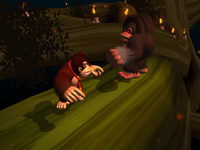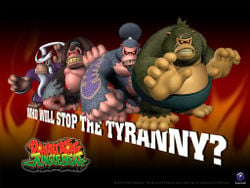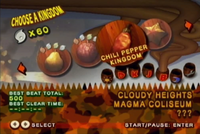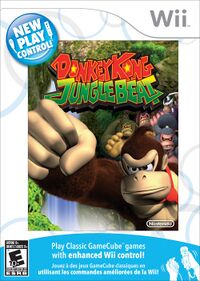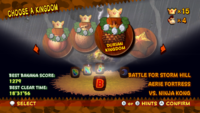Donkey Kong Jungle Beat
Template:Infobox Donkey Kong Jungle Beat is a platformer for the Nintendo GameCube (later ported to Wii) starring Donkey Kong. This game is different from most other platformers in that the player has the option to use the DK Bongos accessory, previously affiliated with the Donkey Konga games, as the controller, though a standard Nintendo GameCube controller may still be used. When released, some copies of the game were packaged with the bongo controller, also akin to Donkey Konga. The game was developed by a division of Nintendo EAD, who would later develop games such as Super Mario Galaxy.
Not counting the earlier arcade ports to the NES and other systems, Donkey Kong Jungle Beat was the first console Donkey Kong game to not be made by Rare Ltd. After they left Nintendo and joined Microsoft, Rare lost control of the Donkey Kong series due to it being trademarked by Nintendo. Because to this, Jungle Beat was very different than the Donkey Kong Country games in gameplay, characters, and, perhaps most notably, the personality of Donkey Kong, who is more aggressive than in past titles. Because of the much more aggressive style of gameplay, Donkey Kong Jungle Beat became the first game to receive the at the time recently conceived rating of "E10+" from the ESRB.
Story
Story From Instruction Booklet:
One day, the peace of the jungle was disrupted by a rampaging pack of wild baddies who wreaked havoc on the residents of the jungle.
Not only that, but they laid claim to every kingdom and stole each one's precious bananas!
"This calls for the one and only Donkey Kong!"
Join forces with your jungle buddies to face an array of powerful enemies and restore peace to the jungle!
Story from Nintendo website (New Play Control!):
Donkey Kong sets out to prove he's king of the jungle and beyond. He rampages through lava caves, savage seas and crazy locales like a ninja-chimp fortress. Only when Donkey Kong defeats all the kings of his world – by boxing with apes, rabid warthogs, ballistic elephants and giant birds – can he call himself king.
Story from European website (New Play Control!)
When an army of invaders infiltrate Donkey Kong’s jungle home and help themselves to every banana they can get their hands on, you know there’s going to be trouble. With a rumbling stomach and the support of some fellow banana-starved buddies, the agitated ape sets out to reclaim what’s rightfully his and liberate the kingdoms he passes through in the process.
During the events of the game, the jungle and various fruit kingdoms are overrun by the various minions of Ghastly King and Cactus King. The bananas from the jungle are also all stolen, scattered throughout the various kingdoms. Donkey Kong decides to help by facing and defeating the kings of each kingdom to both liberate the kingdoms and reclaim the bananas.
During his journeys, in which he defeats the kings in each kingdom, Cactus and Ghastly King both claim to rule the world. However, their plans are thwarted when Donkey Kong arrives and beats Cactus King, and later Ghastly King. The Helper Monkeys and Ninjapes, as well as the four Kongs under Ghastly King and Cactus King, then celebrate the defeat of the duo, with Donkey Kong being named the new king.
When the GameCube version of Donkey Kong Jungle Beat was released, it was stated by game director Yoshiaki Koizumi that "The only thing Donkey Kong needs is to be the best, and to become the king of the jungle."[1] The statement was made due to the original release having nearly no story surrounding or in it; the plot summary above is mostly taken from the New Play Control! version.
Gameplay
The controls of Donkey Kong Jungle Beat are different from most 2-D platformers, in that the player can not only use a standard Nintendo GameCube controller but also the special DK Bongos peripheral. Hitting the left bongo repeatedly will send Donkey Kong running to the left, and hitting the right will send him right. To jump straight into the air, the player must hit both bongos at once. To jump diagonally, the player must hit the bongo in the direction he or she wants to jump, while using the other bongo to run. Hitting both drums in midair causes Donkey Kong to perform a ground pound. Each of the Animal Buddies also feature their own specific controls: With Hoofer, the player must pound the right drum to make him run faster, Helibirds are controlled by pounding each of the drums to fly in that direction, and both drums, one after another, to fly in a mostly straight upward line, and the player can control Flurl by pounding each drum to descend in that direction, and both to descend in a straight line, but slowly. To use the Sound Wave Attack, the player must clap into the microphone, though he or she may alternatively pound the side of the bongo drums. During most boss fights or while fighting certain enemies, the player can punch the bosses by pounding the bongos, and during Kong boss fights their moves can be avoided by clapping or hitting the drum sides.
The GameCube control layout is similar to the bongos; the actions performed by the bongos are mostly incorporated into the ![]() . To move, the player must tap the
. To move, the player must tap the ![]() in the desired direction in order to move Donkey Kong. To jump, the player must press the
in the desired direction in order to move Donkey Kong. To jump, the player must press the ![]() or tap the
or tap the ![]() upwards, and to move in midair, the player must tap the
upwards, and to move in midair, the player must tap the ![]() in the desired direction. To punch, the player must tap the
in the desired direction. To punch, the player must tap the ![]() back and forth repeatedly. Moving any of the Animal Buddies can be achieved once again by tapping the
back and forth repeatedly. Moving any of the Animal Buddies can be achieved once again by tapping the ![]() . The sound wave attack can be used by tapping
. The sound wave attack can be used by tapping ![]() .
.
In the Wii version, the controls are completely different; the player uses the Wii Remote and Nunchuck peripheral to play. To move, the player must tap the ![]() on the
on the ![]() . The sound wave attack can be used by shaking the
. The sound wave attack can be used by shaking the ![]() . Pushing
. Pushing ![]() will allow the player to jump. Punching enemies is accomplished by shaking the
will allow the player to jump. Punching enemies is accomplished by shaking the ![]() and
and ![]() repeatedly. The Animal Buddies are all controlled using the
repeatedly. The Animal Buddies are all controlled using the ![]() .
.
The game also differs from most others in that the goal is to get to the end while also trying to collect as many beats as possible. At the beginning of each kingdom, the player starts with twenty beats (two hundred in the VS. stages; in the port the player starts with none due to the new type of gameplay, but is given 500 as health in Kong of the Mountain), and may obtain more by collecting the beats scattered throughout the stage and defeating enemies. These beats act as health during a level and during the boss battle. In the New Play Control! version, beats are called bananas, and are only used as health during boss battles; hearts replace bananas as health during levels. By using a special technique called a clap grab, the player can collect all the beats in a general area with once move, which increases the beat count by a greater number then by simply running into them individually. Combos, which are obtained by performing special actions (backflips, ground pounds, riding an animal buddy, etc.), also give Donkey Kong more beats than he would be able to obtain normally. A combo continues as long as Donkey Kong is airborne and ends when he hits the ground; the number of beats collected during the combo is then added to the total. Each combo increases the amount of beats earned by simply collecting collecting a banana by the combo number (i.e. running into one banana at a combo ten increases the total number collected by ten). However, if the player is damaged while a combo is active, the player loses all the beats accumulated during the combo. Losing all beats collected in a level and being damaged results in a Game Over, and the player must restart from the beginning of the kingdom. However, in the New Play Control! version, the player has three hearts instead of beats for health, and checkpoints are available where the player starts if all three hearts are lost. The checkpoints were likely added because the 3-heart system allows for less damage to be taken before death. Additionally, the player has a limited number of lives in the Wii version; if all lives are lost, the kingdom must be restarted from the beginning.
Most of the Kingdoms in the game contain three levels: two levels to earn beats, followed by a boss battle. At the end of each level is a fruit, which DK must bite into to complete a level. The player can then play a minigame involving attempting to eat as many bananas as possible in a few seconds; the player then receives extra beats equal to the number of bananas eaten. In the New Play Control! version, before each boss battle, each heart of health remaining also gives the player fifty additional bananas.
Occasionally, the player must play an individual level riding Hoofer the Wildebeest. These levels involve running into frozen beats to collect them, as well as dodging enemies by jumping over them as Hoofer charges toward the fruit at the end of the level. Hoofer may also appear near the fruit at the end of other ice levels. After the fruit, one of two minigames is played riding Hoofer:
- If Hoofer is played as throughout the entire level, the minigame at the end involves gaining as much momentum as possible by jumping off a ramp into the air and flying as far as possible. By using the DK Bongos, the player can slam on the right drum to fly farther. Not jumping off a ram at all results in Hoofer simply flying off the ramp in an uncontrollable spiral. As soon as the player lands, the beat total is counted by using the distance total.
- If Hoofer is found at the end of a level, the minigame played involves jumping over a series of platforms, ending at twenty. Once the player falls or reaches the end, the total is counted, by multiplying the number of successful jumps times ten. Between each platform is two beats flying on top of each other, and every tenth platform has a group of four beats floating between it and the next one. At the end of Asteroid Belt, Iguanagon appears as an optional enemy. Additionally, the floating beats are replaced with Rocs.
As stated above, at the end of each kingdom is a boss level, in which Donkey Kong faces one of four types of bosses: a Kong, a Roc, a Hog, or a Tusk. Each species has a different fighting style and requires a different method to defeat, but the goal is to defeat the boss without losing too many beats, for these beats are necessary in earning crests. These crests are used to unlock new kingdoms, as each one can only be unlocked when a certain number of crests have been obtained. However, in the New Play Control! version of the game, kingdoms are unlocked after the previous kingdom has been completed, and collecting all the crests in one barrel results in a fourth kingdom being unlocked.
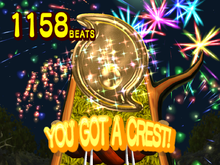
At the end of each kingdom, DK throws a barrel containing his beats into the Sacred Tree, allowing him to obtain up to four crests. The totals to obtain each crest are as follows:
- Below 400 - Bronze crest
- 400 - Silver crest
- 800 - Gold crest
- 1200+ - Platinum crest
In the New Play Control! version, there are only 3 crests per level. Each crest looks identical, but they are worth different numbers of bananas.
- 200 - One crest
- 500 - Two crests
- 1000+ - Three crests
Characters
Main
Animal Buddies
Other
- The Chopperbird
- Three turtles
- Space Dragons
Bosses
|
The Kongs |
The Tusks |
The Rocs |
The Hogs |
Enemies
|
Kingdoms and Bosses
Donkey Kong Jungle Beat contains a total of 19 kingdoms (21 in the New Play Control! version), each one being named after a fruit, with the only deviators being the VS. areas, Opening Ceremony, Kong of the Mountain, and Banana Banquet (the latter two being exclusive to the New Play Control! version). Kingdoms are unlocked by clearing each barrel (and in the D Barrel's case, by clearing Opening Ceremony and the Banana Kingdom), but may not be accessed until the number of crests on each plaque is obtained. As stated above, the kingdoms each contain two levels followed by a boss battle, the deviators once again being the kingdoms listed before. In total, Donkey Kong Jungle Beat contains 50 levels (52 in the port, not counting Kong of the Mountain).
Each Kingdom is selected by choosing one of six "barrels", with each barrel containing four kingdoms, but in the GameCube version, the moon barrel only has two kingdoms, and Opening Ceremony is in its own barrel. The four barrels containing the game's sixteen main kingdoms are the "D", "K", "J", and "B" barrels, which are the letters composing the acronym for Donkey Kong Jungle Beat.
The kingdoms and which barrel they are a part of in the original release are as follows:
| Barrel | Kingdom | Levels | Boss | To Unlock |
|---|---|---|---|---|
| Sun Barrel | Opening | Opening Ceremony | N/A | N/A |
| D Barrel | Banana Kingdom | Dawn Savana | Dread Kong | Clear Opening Ceremony. |
| Jungle Deeps | ||||
| Orange Kingdom | Silver Snow Peak | Scruff Roc | 1 Crest | |
| Sky Garden | ||||
| Watermelon Kingdom | Monkey Fest | Rogue-Hog | 2 Crests | |
| Desert Oasis | ||||
| Apple Kingdom | Massive Canyon | Turret Tusk | 3 Crests | |
| Ice Warren | ||||
| K Barrel | Strawberry Kingdom | Helibird Nest | Mo-Hog (GameCube) Fleet Roc (Wii) |
6 Crests |
| Spirit Tree | ||||
| Pineapple Kingdom | Rumble Falls | Karate Kong | 7 Crests | |
| Pristine Sea | ||||
| Lemon Kingdom | Chopperbird Race | Fleet Roc (GameCube) Mo-Hog (Wii) |
8 Crests | |
| Cactus Mine | ||||
| Grape Kingdom | Sweet Paradise | Grave Tusk (GameCube) Hard Roc (Wii) |
9 Crests | |
| Primeval Ruins | ||||
| J Barrel | Cherry Kingdom | Aurora Glacier | Hard Roc (GameCube) Grave Tusk (Wii) |
12 Crests |
| Grim Volcano | ||||
| Peach Kingdom | Arctic Plunge | Torch Tusk (GameCube) Bloat-Hog (Wii) |
14 Crests | |
| Ancient Foundary | ||||
| Melon Kingdom | Iguanagon's Realm | Bloat-Hog (GameCube) Torch Tusk (Wii) |
16 Crests | |
| Banshee Swamp | ||||
| Durian Kingdom | Battle for Storm Hill | Ninja Kong | 18 Crests | |
| Arie Fortress | ||||
| B Barrel | Pear Kingdom | Deep Sea Sprint (GameCube) Helibird Dash (Wii) |
Gloat-Hog | 25 Crests |
| Clock Tower | ||||
| Lychee Kingdom | Helibird Dash (GameCube) Deep Sea Sprint (Wii) |
Thunder Roc (GameCube) Double Tusk (Wii) |
29 Crests | |
| Lava Cavern | ||||
| Chili Pepper Kingdom | Cloudy Heights | Double Tusk (GameCube) Thunder Roc (Wii) |
34 Crests | |
| Magma Coliseum | ||||
| Star Fruit Kingdom | Ninjape Rally | Sumo Kong | 41 Crests | |
| Asteroid Belt | ||||
| Moon Barrel | VS. Cactus King | Cactus King | 22 Crests Beat D-J Barrels | |
| VS. Ghastly King | Ghastly King | 51 Crests Beat B Barrel |
Sequels
In Japan, two sequels to Donkey Kong Jungle Beat were developed by Capcom and released onto Sega's Triforce arcade machine:
- Donkey Kong: Jungle Fever (2005)
- Donkey Kong: Banana Kingdom (2006)
"New Play Control!" series
Donkey Kong Jungle Beat was later re-released on the Wii as part of the "New Play Control!" series, a series of Nintendo GameCube titles remade specifically to take advantage of the Wii's motion controls. It was released in Japan on December 11, 2008[2], North America on May 4, 2009, and in Europe on June 5, 2009. The game is played with the Wii Remote and Nunchuk[2], offers a wide-screen mode,[3] and several changes to the levels as well. Gimmicks and enemies may be found at different places than the original game. There are no completely new levels, but there are two new locations in the Kingdom selection screen: a boss rush[2] (Kong of the Mountain) and the Ceremony stage from the GameCube version[2] (Banana Banquet). As such, this is the only New Play Control! game to feature content exclusive to this version.
Donkey Kong is controlled with the Analog Stick of the Nunchuk, and to clap the player has to flick the Wii Remote. Unlike the original game, Donkey Kong's claps can face different directions[2]. There are also new enemies, such as line-guided balls of electricity, and obstacles, like cacti[2]. The crest system has been revised - there are no longer different crests, but a number of crests (up to three for each kingdom) the player can still win by getting a certain number of bananas[2]. Collecting all of the crests in one barrel results in the player unlocking the fourth kingdom in that barrel.
Other Changes
- The game has a storyline, which wasn't present anywhere in the original game, not even the manual.
- Six different save files are available, unlike the original, which has only one per memory card.
- Beats are now simply called bananas.
- Bananas (formerly beats) are not as an energy meter during the levels themselves; instead, they are only used as health during kingdom boss battles. During normal levels, the player has three hearts as health.
- The player has a limited number of lives.
- The dancing panda bear is now a blue bear.
- Checkpoints have been added.
- Party Monkeys are scattered around various points of kingdoms to give the player advice.
- The Yukimoguras have been removed from Silver Snow Peak for unknown reasons, replaced with unknown obstructions. Several pits have also been added to the course.
- New types of enemies have been added.
- Barrel Cannons have been added and are now used in the place of the launching plants from the original.
- Donkey Kong now wears a crown after defeating a boss. The crown could also be worn during gameplay after the player completes the game with all crests and crowns.
- There are now 60 crests instead of 72, and they no longer have a variety of different colors; every one of them is silver/platinum.
- Some boss and level locations have been moved to different kingdoms.
- Each barrel has three kingdoms to beat, with a fourth being unlocked after the player has obtained all the crests in the barrel.
- Donkey Kong can no longer use Clap Grabs underwater and/or in the air (while using Animal Buddies such as Helibird or Flurl).
- The Karate Kong battle is shown from a different camera angle while Donkey Kong is punching.
- Due to closer camera angles, a zoomed-in image of Donkey Kong is no longer shown at the bottom left-hand corner of the screen.
- Opening Ceremony can no longer be selected once the player has completed it.
- During Opening Ceremony, Donkey Kong may also save various Party Monkeys trapped inside bubbles by using the Sound Wave Attack.
- Stacks of logs have been added to various parts of levels.
- Bananas have been added at various points.
- Kingdoms are unlocked after the previous one has been completed, as opposed to gathering a certain number of crests.
- Blooms give the player an extra life for collecting one hundred of them instead of giving one hundred beats/bananas.
- The player is awarded a 1-Up token for collecting certain amounts of bananas (200, 500, 1000, 1500, etc.)
New Kingdom and Barrel Locations
In the New Play Control! version, there are three kingdoms per barrel, with a fourth one that has to be unlocked by obtaining all nine crests in the first three. The three kingdoms in each barrel are unlocked by clearing the previous one. The unlocked kingdoms are the kingdoms that were originally in the B Barrel from the original game. The order they appear in is as follows:
|
|
|
|
|
* - These stages only appear in the New Play Control! version.
Reception
Donkey Kong Jungle Beat was well received. Rated the 95th best game made on a Nintendo system in the Top 200 Games List by Nintendo Power in its February 2006 issue, the game's main criticism was its short length and departure from the classic Donkey Kong Country gameplay. Jungle Beat has also received praise for its graphics and unique control, which many critics have called innovative. IGN gave the GameCube version an 8.8[1], and the Wii port an 8.4[4]; GameSpot gave the game a 7.0, [5] and GamesRadar gave it 4/5 stars[6]. As stated above, the game's primary criticism is in its short length.
References to Other Games
- Donkey Kong: At the very beginning of the Cactus/Ghastly King battles, part of the music that plays is a remix of the tune that plays when Donkey Kong climbs atop the construction site with Pauline.
- Donkey Kong Country: The entire concept of collecting bananas and riding Animal Buddies originated from this game. Additionally, the background music that plays in Dawn Savanna, after clearing any boss stage, and the ending are remixes of the Jungle Hijinxs theme. Lastly, voice clips from Funky Kong's theme can be heard towards the end of the Opening Ceremony.
References in Later Games
- Mario Kart DS: Many of Donkey Kong's voice clips from Donkey Kong Jungle Beat are reused for this game.
- DK: Jungle Climber: Many voice clips are reused in this game as well. Also, the pose that Donkey Kong strikes after completing the bonus stage (where the player has to catch bananas with a barrel) is identical to the pose that he strikes in Jungle Beat after completing the banana-eating bonus at the end of each stage.
- Super Mario Galaxy: There are a few gameplay mechanics from Donkey Kong Jungle Beat reused in this game, including sound effects. Also, Party Monkeys and Haribonbons were originally going to appear as enemies in this game.
- Super Smash Bros. Brawl: Rumble Falls is a default stage that can be selected in the game, and the background also changes rapidly, with one of them being the background that was used in the Sky Garden stage. Also, the song, "Battle For Storm Hill", in its original form, may be selected as background music for that stage and custom stages. Lastly, the Party Monkey, Gale Hawg, Hoofer, Karate Kong, and Donkey Kong's appearance in this game appear as Stickers, and Helibird and Turrent Tusk appear as Trophies.
Gallery
Quotes
- Main article: List of quotes in Donkey Kong Jungle Beat
Beta Elements
- Main article: List of Donkey Kong Jungle Beat beta elements
Staff
- Main article: List of Donkey Kong Jungle Beat staff
Name in Other Languages
External Links
- Japanese Site
- European English (New Play Control!) Site
- New Play Control! Donkey Kong Jungle Beat at Nintendo
- Japanese New Play Control! Site
References
- ^ a b Donkey Kong Jungle Beat - IGN
- ^ a b c d e f g WiiFolder » Blog Archive » Video Demo - Donkey Kong Jungle Beat, accessed 2009-01-12
- ^ Gametrailers.com - Donkey Kong Jungle Beat - Japanese Debut Trailer *No Sound*, trailer of the Wii version
- ^ [1]
- ^ Donkey Kong Jungle Beat Review - GameSpot.com
- ^ Donkey Kong Jungle Beat Review - GamesRadar
